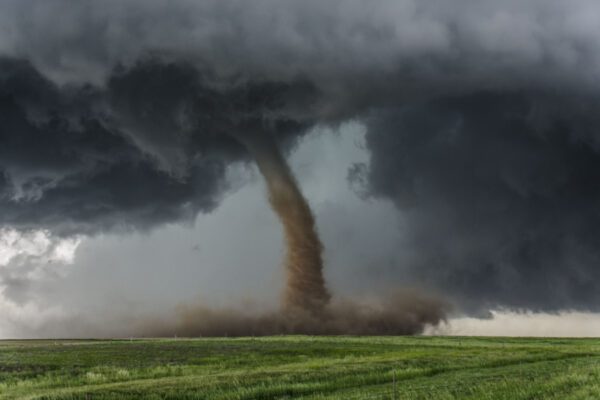Spawned from powerful thunderstorms, tornadoes can cause fatalities and devastate neighborhoods in seconds. A tornado appears as a rotating, funnel-shaped cloud extending from a thunderstorm to the ground with winds reaching 300 mph. Damage paths can be more than a mile wide and 50 miles long. Some tornadoes are clearly visible, while others may be obscured by rain or clouds.
Occasionally, tornadoes develop so rapidly that little, if any, warning is possible. This is why it’s important to be prepared ahead of time. In order to prepare for a tornado in your community, consider the following guidance.
Before the Storm
Before a tornado hits, the wind may die down, and the air may become very still. A cloud of debris can mark the location of a tornado even if a funnel is not visible. Tornadoes generally occur near the trailing edge of a thunderstorm. It is not uncommon to see clear, sunlit skies behind a tornado.
There are some simple steps you can take to protect your home and family from tornadoes:
- Prepare an emergency kit and develop a family communication plan.
- Monitor your phone, radio, or television for the latest information regarding tornado risks. In any emergency, always listen to the instructions given by local officials.
- Be alert to changing weather conditions. Watch for the following warning signs:
- A dark, often greenish sky
- Large hail
- A large, dark, rotating cloud
- A loud roar
If you see any warning signs or an approaching storm, be prepared to take shelter immediately.
When a Tornado Strikes
If you are under a tornado warning, seek shelter immediately. Most injuries from high winds are from flying debris, so remember to protect your head.
| If you are: | Then: |
| In a structure (e.g., a residence, small building, school, nursing home, hospital, factory, shopping center or high-rise building) |
|
| In a trailer or mobile home |
|
| Outside with no shelter |
|
Consider a Safe Room
Extreme storms pose a serious threat to buildings and their occupants. Your residence may be unable to withstand winds from severe weather, such as tornadoes and hurricanes. A safe room or wind shelter provides a space where you and your family can seek refuge. You can build a safe room in one of several places in your home, including:
- Your basement
- Atop a concrete slab-on-grade foundation or garage floor
- An interior room on the first floor
Below-ground safe rooms must be designed to avoid accumulating water during the heavy rains often accompanying severe windstorms. Consider the following when building a safe room:
- The safe room must be adequately anchored to resist overturning and uplift.
- The shelter’s walls, ceiling and door must withstand wind pressure and resist penetration by windborne objects and falling debris.
- The connections between all parts of the safe room must be strong enough to resist the wind.
After a Tornado
Injuries may result from the direct impact of a tornado, or they may occur afterward when people walk among debris and enter damaged buildings. A study of injuries after a tornado in Marion, Illinois, showed that 50% of tornado-related injuries were suffered during rescue attempts, cleanup, and other post-tornado activities. Nearly one-third of those injuries resulted from stepping on nails.
Since tornadoes often damage power lines, gas lines and electrical systems, there is a risk of fire, electrocution or even explosion. Protecting yourself and your family requires prompt treatment of injuries suffered during the storm and taking extreme care to avoid further hazards.
General Safety Precautions
Here are some safety precautions that can help you avoid injury after a tornado:
- Continue to monitor your phone, radio or television for emergency information.
- Wear sturdy shoes or boots, long sleeves and gloves when handling or walking near debris.
- Be aware of hazards from sharp objects—such as exposed nails and broken glass.
- Do not touch downed power lines or objects in contact with these lines. Report electrical hazards to the police and the utility company.
- Consider using battery-powered lanterns rather than candles to light homes without electrical power. If you use candles, ensure they are in safe holders and kept away from curtains, paper, wood, or other flammable items. Never leave a candle burning when you are out of the room.
Inspecting the Damage
You may be tempted to inspect the damage a tornado causes after a storm, but keep these safety tips in mind:
- After a tornado, be aware of possible structural, electrical or gas-leak hazards in your home. Contact your local city or county building inspectors for information on structural safety codes and standards.
- If you suspect any damage to your home, shut off electrical power, natural gas and propane tanks to avoid fires, electrocution or explosions.
- If you see frayed wiring or sparks, or if there is an odor of something burning, you should immediately shut off the electrical system at the main circuit breaker.
- If you smell gas or suspect a leak, turn off the main gas valve, open all windows and leave the house immediately. Notify the gas company, the police or fire department and do not turn on the lights, light matches, smoke, or do anything that could cause a spark. Do not return to your house until you are told it is safe.
The Horton Group, Inc. is committed to helping you and your loved ones stay safe when disaster strikes. To learn more about how you can mitigate risk, contact our personal insurance professionals today.
Material posted on this website is for informational purposes only and does not constitute a legal opinion or medical advice. Contact your legal representative or medical professional for information specific to your legal or medical needs.




